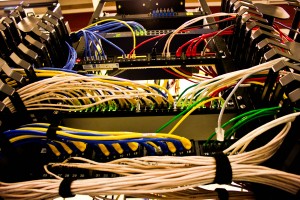Hesston College Internet: Avoiding the 600 semi-truck pileup

by Josh Booth – Horizon News and Features Editor
It can be argued all college students need only three basic things to be able to function: food to provide energy throughout the day, enough sleep to recharge the body, and the Internet. Whether it is trying to keep up on their social lives through Facebook, trying to stream a movie late at night, or turning in a huge paper last minute, students seem to be chained their computers. However, it often feels like the Internet is lagging behind.
“I occasionally become frustrated with the Internet speed while I am trying to research for my projects,” said Freshman Jeffrey Smoker.
Russ Neufeld, the Network Manager of Hesston College, is the man who helps address complaints like Smoker’s. He says that Hesston’s information technology department is doing what they can to deal with the speed issue, but they have their work cut out for them.
“Internet usage on campus has grown extremely quickly,” Neufeld said. “We expected this, but didn’t fully anticipate the rate of growth. In the last 2.5 years we have increased the size of the campus connections three times, and yet demand has continued to outstrip supply.”
It isn’t just the total usage though that can be a problem. The ways people use the Internet can also be an issue. Trying to load a hilarious but long YouTube clip uses more of the Internet traffic, and can be a hindrance to the speed. Think of it as each person on campus driving his or her own semi-truck, trying to merge onto the interstate at the same time. It is going to require a bit of waiting.
“We support roughly 600 student and employee users, as well as 150 classrooms and labs,” said Neufeld. “With this much load on the network, we employ a number of technologies such as packet shaping and policy enforcement, to ensure we keep our connection as functional and fair as possible.”
One factor for connection speed could be which network is being used. Students are often encouraged to connect their wireless devices to the HC_Secure network (per instructions on http://Helpdesk.Hesston.edu). Russ has purposely made the guest network smaller so students and employees stay off of it, and so it can serve the visitors to Hesston.
There is not a lot students can do by themselves to make the Internet faster. However, there are a couple small things that could help, one being the time you are using the Internet. The network is its emptiest from 3-8 a.m. The Internet is likely to be speedy during this time, but being awake early enough to use it can be debatable.
Students can also make sure they report issues when they occur. Russ is here to help, but reminds students he cannot fix things he does not know about. He relies on students to keep him informed.
“If you’re having trouble with signal strength or other issues, send that information to helpdesk@hesston.edu.”


